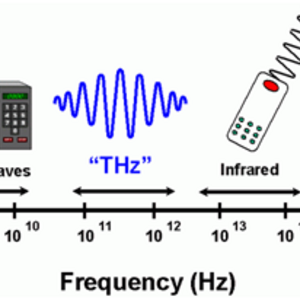What Are Terahertz Radiations?
The Terahertz (THz) region of the electromagnetic spectrum commonly includes all the frequencies between 100 GHz (3 mm) and 10 THz (30 μm) as shown on figure 1.

Those waves are similar to the waves used in a microwave, a cell phone, or for computer wireless transmission; except that they do not have the same frequency.
| Entity | Frequency using prefix | Frequency with no prefix |
|---|---|---|
| UMTS/HSPA (4G LTE) | 1700 MHz in the USA1 | 700 000 000 Hertz |
| Wifi | 2.4 GHz (and 5 GHz) band2 | 400 000 000 Hertz |
| Water absorption signature | 1.6 THz1 | 600 000 000 000 Hertz |
| Color blue (480 nm) | 624 THz | 624 000 000 000 000 Hertz |
The photons of the THz domain have an energy between 0.42 and 41 meV. Due to this low energy, THz radiations are non-ionizing and therefore not dangerous for human beings. Unlike radiations with higher energy, such as X-rays and UV radiation.
THz frequencies are located between the microwaves and the infrared waves of the electromagnetic spectrum. Thanks to that unique location, THz waves have the advantage of the 2 adjacent frequency ranges: it is possible to manipulate the waves with optics (mirrors, lenses) as well as electronic technologies (coplanar waveguides, probes).
In addition, some materials like clothing, paper, plastic, or bricks are transparent to THz waves. Therefore, it is easy to perform imaging behind these materials and others that are transparent to terahertz radiation.
Even if the THz field is a fairly young (~25 years old), there is already many applications in different fields:
Applications are discovered every day, making this filed one of the most exciting of the past few decades.